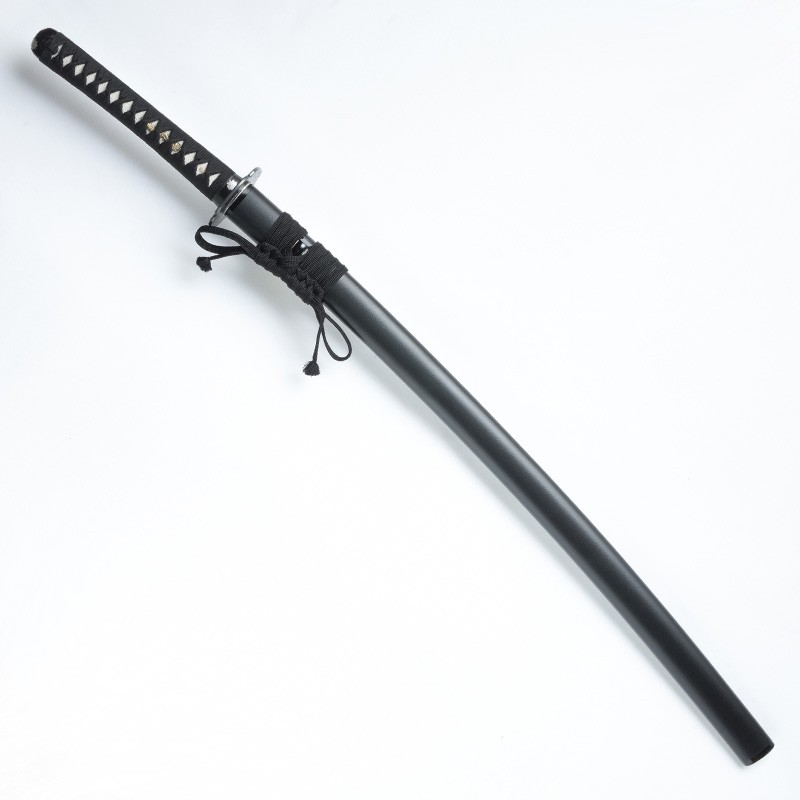














More informations about this product
The Koto Koshirae 古刀拵 is a montage of elements from swords before the Edo period, before 1600. In the classification of traditional sword-making eras, productions prior to the Edo period are called 'Koto' 古刀, literally 'Ancient Swords'.
This assembly is quite sober and tends towards efficiency. We will appreciate this simple elegance, with noble materials (silk and silver inlay). The decorative elements, Tosogu, refer to ancient symbols and legends.
The Menuki are based on Mukade 百足, considered the messengers of Bishamonten, guardian of the north, gods of war and protector of Buddhist law. There is a legend about a Yokai 'O-Mukade', a giant scolopendra living in mountains and caves. Venomous, very powerful and aggressive, with an almost indestructible exoskeleton, the O-Mukade can compete with the Dragons. Legend has it that Fujiwara No Hidesato, a seasoned Bushi, is called for help by the Daughter of the Dragon King of Lake Biwa because an O-Mukade is said to have taken up residence on Mount Mikami. When Hidesato arrived on the spot, he realized that the O-MukadeMukade was so tall that he surrounded the mountain 7 times. Hidesato then took an arrow and put his saliva on the tip, praying to Hachiman, the god of war. The tip then crossed the armor and killed the O-Mukade.
The snowflakes 雪花 patterns on the Fuchi and Kashira are symbols of purity. With their 8 branches, they can also represent the 8-spoke 'Wheel of Dharma' (Darmachakra), also called 'The Noble Eightfold Path' leading to deliverance, Nirvana. The 8 values are right understanding, right thinking, right speech, right action, right livelihood, right effort, right attention, right focus. These teachings lead to the "Middle Way", avoiding both the pursuit of happiness in dependence, and the pursuit of liberation in the practice of excessive asceticism.
The tsuba’s Amaryu (or Uryu) 雨龍 pattern represents the rain dragon, also called 'Chiryu'. Strong and powerful mythological deity, able to control the element of water, it is a symbol of protection against fire.
The blade type for this fixture is a semi-heavy blade, approximately 970g.
Nagasa length possible from 2.20 尺 (66.6cm) to 2.70 尺 (81.8cm).
size charts (see attached table of recommended sizes)
Hamon: Notare (Wave Pattern).
Habaki: Shonai (old-fashioned design), made of brass. Silver seppa.
Tsuba: Dragon Design in the Rain (Amaryū - 雨龍), quadrilobed shape (Mokko Gata), blackened iron.
Fuchi/ Kashira: Fuchi Kashira are rounded, made of blackened iron with a silver Zogan-type inlay in the snowflake pattern 'Higo Yukibane' 肥後雪花.
Same: Galuchat (Roussette or Raie), White.
Menuki: Golden Mukade (Scolopendra - 百足), symbols of strength, and Bishamonten’s messenger.
Tsukaito: Black cotton Hineri Maki handle braiding.
Sageo: Genuine black silk.
Saya: Lacquer Hon Kuro Ishime 本黒石目 (black matt lacquer), Magnolia wood, and Shitodome silver.
The Minosaka Workshops :
The Iaito we offer come from Minosaka workshops in Gifu, Japan, and are manufactured in their workshop in Japan.
Gifu is one of the top places known for the forging of traditional sabres, including the Mino tradition, dating from the 14th century. Minosaka workshops are Iaito’s leading producers of tradition.
This traditional workshop manufactures its chrome-plated Zamak Iaito (Zinc and Aluminum alloy with some Copper) which is stainless.
This non-ferrous alloy makes the Iaito blunt and unsharpenable:
They are practical tools for Kata, without contact between the blades.
Items that may interest you
Share your opinion
error Your review appreciation cannot be sent
feedback Report comment
check_circle Report sent
error Your report cannot be sent